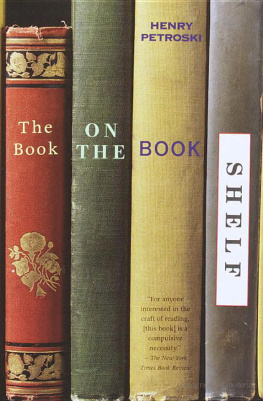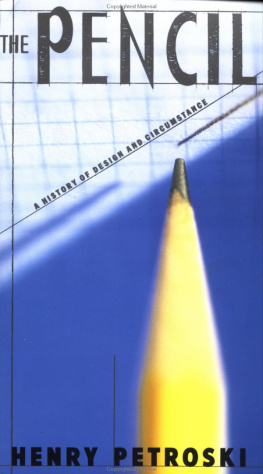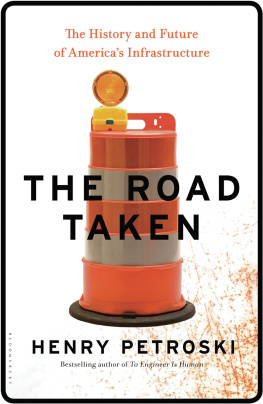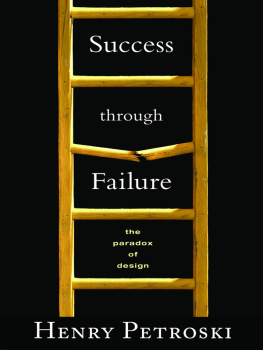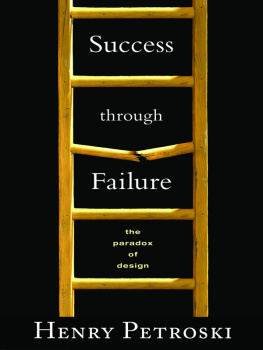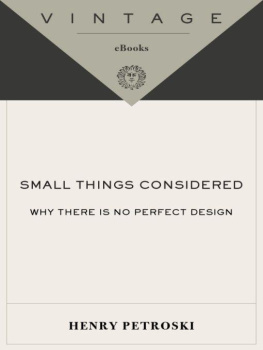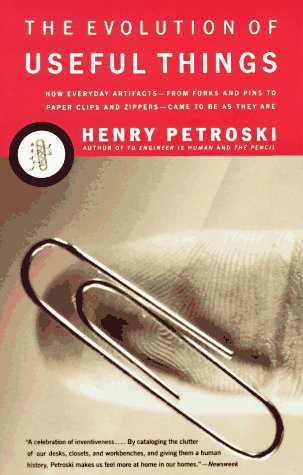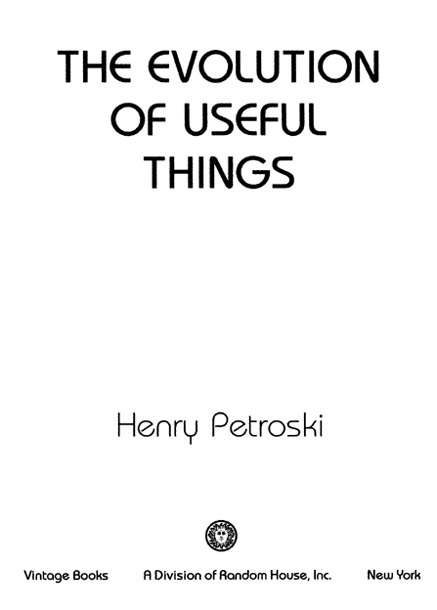Acclaim for Henry Petroskis
THE EVOLUTION OF USEFUL THINGS
[It] offers the reader many fascinating data about human artifacts. Petroski is an amiable and lucid writer. He belong[s] with the poets, extending the Romantic embrace of nature to the invented, manufactured world that has become mans second nature.
John Updike, The New Yorker
Petroski weaves wonderfully odd facts into this book. [He] makes us pay attention to ordinary objects just the ticket for the technophile.
Los Angeles Times
A constellation of little marvels [that] all make good stories. [A] paean to Yankee ingenuity an informative, entertaining book.
Boston Globe
One has to admire a man who delivers an intelligent tirade on a garbage bag. Readable and entertaining Petroski liberally mixes biography, social history, design theory and even word derivations into these affectionately told tales.
Chicago Tribune
This book is a monument to the historians curiosity and the engineers tenacity. It is a treasure trove of fascinating facts and amusing anecdotes.
New Criterion
BOOKS BY HENRY PETROSKI
The Book on the Bookshelf
Remaking the World
Invention by Design
Engineers of Dreams
Design Paradigms
The Evolution of Useful Things
The Pencil
Beyond Engineering
To Engineer Is Human
Paperboy
Small Things Considered
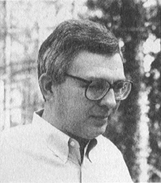
Henry Petroski
THE EVOLUTION OF USEFUL THINGS
Henry Petroski is the Aleksandar S. Vesic Professor of Civil Engineering and a professor of history at Duke University. He is the author of more than ten books.
FIRST VINTAGE BOOKS EDITION, FEBRUARY 1994
Copyright1992 by Henry Petroski
All rights reserved under International and Pan-American Copyright Conventions. Published in the United States by Vintage Books, a division of Random House, Inc., New York, and simultaneously in Canada by Random House of Canada Limited, Toronto. Originally published in hardcover by Alfred A. Knopf, Inc.,
New York, in 1992.
Some of this material first appeared, in different form, in
American Heritage of Invention and Technology, Technology Review,
Wigwag, and Wilson Quarterly.
Grateful acknowledgment is made to the following for permission to reprint previously published material:
Barrie &Jenkins: Excerpts from The Nature and Aesthetics of Design by David Pye (Barrie & Jenkins, London, 1978). Reprinted by permission of Barrie & Jenkins, a division of The Random Century Group Limited.
Caliban Books: Excerpt from William Smith, Potter and Farmer, 17901858 by George Sturt (Caliban Books, London, 1978). Reprinted by permission.
HarperCollins Publishers Inc.: Excerpts from Etiquette: The Blue Book of Social Usage by Emily Post. Copyright 1965 by Funk and Wagnalls Co., Inc. Reprinted by permission of HarperCollins Publishers Inc.
Harvard University Press: Excerpts from Notes on the Synthesis of Form by Christopher Alexander (Harvard University Press, 1964). Reprinted by permission.
Library of Congress Cataloging-in-Publication Data
Petroski, Henry.
The evolution of useful things / Henry Petroski.1st Vintage Books ed.
p. cm.
Originally published: New York: A. Knopf, 1992.
eISBN: 978-0-307-77305-0
1. Inventions. 2. Patents. I. Title.
T212.P465 1994
609dc20 93-6351
Author photograph Catherine Petroski
v3.1
to my mother,
and to the memory of my father
Contents
Preface
O ther than the sky and some trees, everything I can see from where I now sit is artificial. The desk, books, and computer before me; the chair, rug, and door behind me; the lamp, ceiling, and roof above me; the roads, cars, and buildings outside my window, all have been made by disassembling and reassembling parts of nature. If truth be told, even the sky has been colored by pollution, and the stand of trees has been oddly shaped to conform to the space allotted by development. Virtually all urban sensual experience has been touched by human hands, and thus the vast majority of us experience the physical world, at least, as filtered through the process of design.
Given that so much of our perception involves made things, it is reasonable to ask how they got to look the way they do. How is it that an artifact of technology has one shape rather than another? By what process do the unique, and not-so-unique, designs of manufactured goods come to be? Is there a single mechanism whereby the tools of different cultures evolve into distinct forms and yet serve the same essential function? To be specific, can the development of the knife and fork of the West be explained by the same principle that explains the chopsticks of the East? Can any single theory explain the shape of a Western saw, which cuts on the push stroke, as readily as an Eastern one, which cuts on the pull? If form does not follow function in any deterministic way, then by what mechanism do the shapes and forms of our made world come to be?
Such are the questions that have led to this book. It extends an exploration of engineering that I began in To Engineer Is Human, which dealt mainly with understanding why made things break, and that I continued in The Pencil, which traced the evolution of a single artifact through the cultural, political, and technological vicissitudes of history. Here I have focused not on the physical failings of any single thing but, rather, on the implications of failurewhether physical, functional, cultural, or psychologicalfor form generally. This extended essay, which may be read as a refutation of the design dictum that form follows function, has led to considerations that go beyond things themselves to the roots of the often ineffable creative processes of invention and design.
As artifacts evolve from artifacts, so do books from books. In writing this one, I have once again benefited from the physical and intellectual resources of many libraries and librarians. As always, I acknowledge Eric Smith, head of Duke Universitys Vesic Engineering Library, who remains ever-patient in the face of my frequently vague requests for often obscure sources, and even pursues avenues of information I would never have dreamed of following. Stuart Basefsky, of the Public Documents Department in Dukes Perkins Library, helped me get oriented in patent literature, which proved to be so important for my case, and the patent repository of the D. H. Hill Library of North Carolina State University graciously filled my numerous requests for documents. Several manufacturers, by freely providing their company histories, catalogues, and ephemera, enabled me to read beyond library walls and find invaluable documentation of things as they have been and are. Also, many friends, readers, and collectors generously shared with me art, facts, and artifacts that have found their way into my work. Where I have remembered my debts, I have acknowledged them in the notes at the end of this volume.


